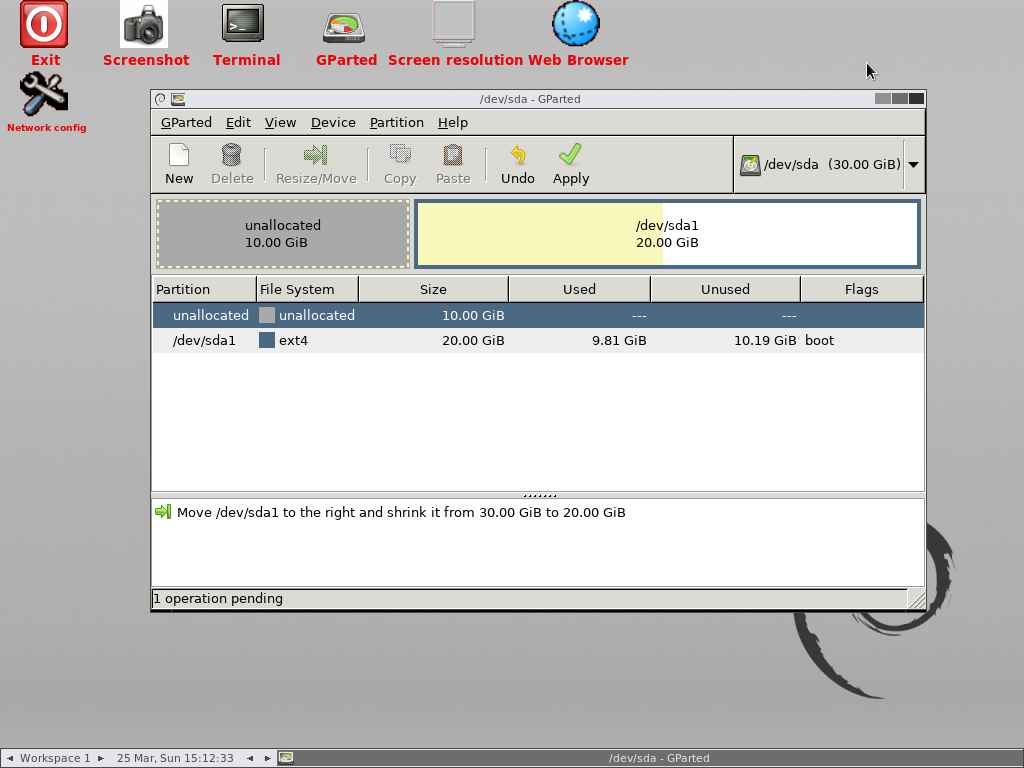

- #RESIZE ROOT FROM GPARTED LIVE USB INSTALL#
- #RESIZE ROOT FROM GPARTED LIVE USB PRO#
- #RESIZE ROOT FROM GPARTED LIVE USB CODE#
- #RESIZE ROOT FROM GPARTED LIVE USB ISO#
#RESIZE ROOT FROM GPARTED LIVE USB PRO#
Binary signals pro for trading options only alert the user to the situation on the market and Binary Option Parted Resize Partition Centos 7 Account give recommendations for action, while robots can execute transactions on behalf of the user and from his account.
#RESIZE ROOT FROM GPARTED LIVE USB ISO#
Assign the downloaded ISO in your VMware CD-ROM drive and boot from it. To manage the partitions, we're using GParted, which is available as bootable ISO-Image. Now we have some more space for partitions in our VM but we want to increase the size of an existing partition.~]# fdisk -l /dev/sda Disk /dev/sda: 15 GiB. Before we resize primary partition, let us list the available partitions. Similar to parted command, you can also use fdisk utility to resize primary partition and extend non lvm root partition. Method 2: Change size of partition using fdisk utility.WARNING! Although unlikely (each step is reversible), resizing your encrypted partitions may result in data loss. GUI tools such as Gparted see the LUKS container or crypt as unpartitioned space and thus resizing encrypted partitions must be performed entirely from the command line. Resizing an encrypted partition is somewhat complicated.After running the resize command, you will want to verify your changes by printing the partition table and comapring with the original values of the table prior to the changes. The NUMBER of the partition to resize from the above table is '4' - the extended partition (parted) resize 4 11.3GB 223GB.In a Kobo ereader modification I used this to resize the 3rd partition of internal memory to the maximum: (it blindly assumes there to be no 4th partition and msdos table and things) Old versions of parted had a resize command that would resize both partition and filesystem in one go, it even worked for vfat.Figure 2 shows a resizing of /dev/sdb7 from Figure 1, moving its start point to the right to make room for an expansion of /dev/sdb5. GParted provides a point-and-click interface for resizing partitions. You can adjust the size and position of the partition using the graphical slider or the text-entry fields.We recommend you use parted only to manipulate partition tables, whenever possible.

#RESIZE ROOT FROM GPARTED LIVE USB CODE#
parted's file system manipulation code is not as robust as what you'll find in dedicated, file-system-specific packages like e2fsprogs.

To do so, right click the main partition and choose Resize/Move. Note the mount point of this partition…it's probably /media/pi/boot or similar. The first "real" partition is a FAT16 filesystem…that's the boot partition on the target system SD card.
#RESIZE ROOT FROM GPARTED LIVE USB INSTALL#
There is of course an easy fix for this: apt-get install gparted.If your filesystem is XFS, it can be grown while mounted using the xfs_growfs command: Congratulations!, you have successfully resized an ext2/3/4 or XFS root partition on Linux without LVM. The filesystem on /dev/vda1 is now 7864059 blocks long. Step 4: Resize '/' partition to fill all space.Expanding disk partitions to use all the available (unallocated) disk space is a common issue among Linux Administrators, expecially when working in a VMware-based Cloud environment: deploying a Linux VM from an existing template will often lead to disk partitions smaller than the disk space allocated during the VM configuration phase.


 0 kommentar(er)
0 kommentar(er)
